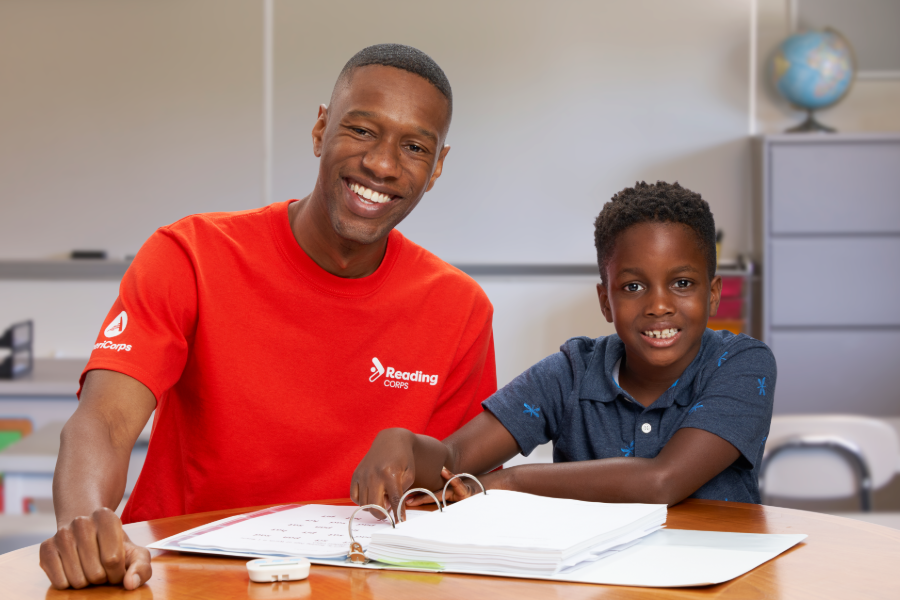In the year 2000, the National Reading Panel released a report summarizing the most effective techniques for reading instruction. After reviewing more than 30 years of research, the five skills they identified as critical were phonological awareness, phonics, fluency, vocabulary, and comprehension. In education circles, these skills are now known as the Big 5.
Aligned with Research
Reading Corps launched in 2003, with the goal of applying the science of reading to better help the students who need additional support. While all five skills are essential to effective reading instruction, the research and development team identified the first three as areas tutors would be most impactful. They designed Reading Corps to support the key skills of phonological awareness, phonics, and fluency, which together build the foundation for both reading and lifelong learning.

Phonological Awareness
The first and most fundamental skill that our tutors help students practice is phonological awareness. This is a cornerstone of early literacy instruction and the first step in learning to read.
“A phoneme is the smallest unit of sound in spoken words,” explains Anne Sinclair, Chief Learning Officer at Ampact. “Cat, for example, has three phonemes: c, a, and t each have their own sound that come together to make up the word. Hearing the specific sounds that make up words and being able to tell them apart, that’s phonological awareness.”
Getting the hang of phonemes can be tricky for a lot of young students, especially because there are more phonemes than you’d expect. Although English only has 26 letters, there are 44 unique phonemes in the language. As students work on hearing and differentiating between phonemes with the help of their tutors, they also use those new abilities to practice the second essential skill: phonics.

Phonics
Phonics is the process of connecting the sounds you hear in words to the letters that represent them. In our “cat” example, it’s easy for people who have been reading for decades to understand that the word cat has three sounds (/c/, /a/, and /t/) and there are three letters that represent them. But for many students, forming these connections takes extra time and practice.
Through daily, targeted sessions, tutors support students who need a little extra help building the critical skill of connecting sounds to letters (or letter combinations.) Once that connection is established, it allows students to approach words on the page as little puzzles that they now have the skills to unlock!
Once students can identify that letters represent specific sounds, they can put the sounds together to make whole words. This use of phonics is called decoding words, which is the next step toward literacy. The jump from connecting sounds to letters, then letters to words, then words to sentences, leads us right to the final essential skill: fluency.

Fluency
Fluency refers to a student’s ability to not just decode individual words but to read them accurately, at an appropriate speed, and in a way that sounds like spoken language, also known as ‘expression.’ Fluency is the link between word reading and reading comprehension. As students improve from breaking down individual letters in words, to recognizing whole words, to stringing together multiple words, and sentences, they’re improving their fluency!
“Fluency is the bridge between those decoding skills and true comprehension,’ says Sinclair. “If you’re spending all of your cognitive effort on reading the individual words, you have less cognitive capacity available for understanding what you’re reading. The harder you have to work on each word, the harder it is to comprehend the overall meaning of what you read.”
Building Skills, Achieving More
Reading Corps targets these foundational skills so that students have access to the content being taught in their classrooms, without jumping ahead of any classroom instruction. Phonological awareness, phonics, and fluency are the building blocks for reading proficiency, which not only helps them excel on their current classroom lessons but also becomes the primary way students learn across all future grades, in all subjects, and throughout the rest of their lives.
“Our targeted interventions help ensure that every student can become strong readers by third grade, which is a critical time for student development,” says Sinclair. “We help students learn to read so that they can read to learn!”
Best of all, the skills Reading Corps supports have been proved to boost student’s reading ability and test scores. Rigorous evaluations of Reading Corps through multiple scientific studies have demonstrated significant positive effects on student outcomes.
To learn how you can bring Reading Tutors to your school or how to become a tutor yourself, visit readingandmath.org/programs/reading-corps.
